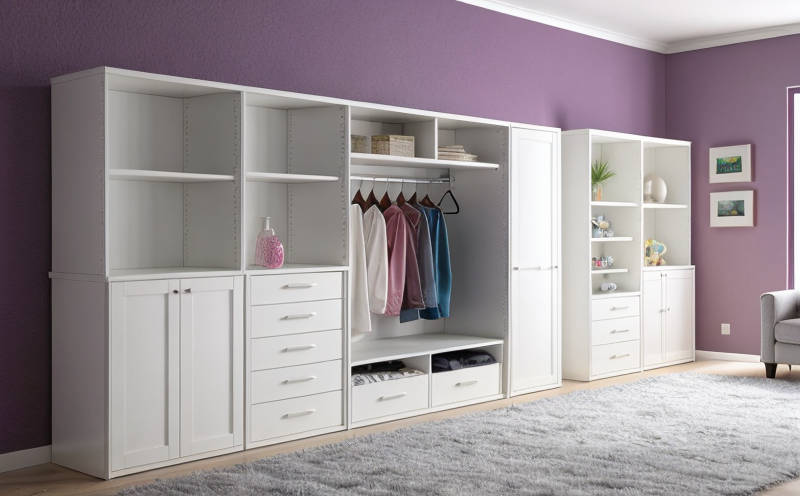JIS S 1103 Strength Testing of Wardrobe and Cabinet Doors
The JIS S 1103 strength testing method is a critical procedure in ensuring the durability, reliability, and safety of wardrobe and cabinet doors. Developed by Japanese Industrial Standards (JIS), this test evaluates the structural integrity of these components under static loads to ensure they can withstand typical environmental stresses and user pressures without failure.
This standard applies specifically to wardrobe and cabinet doors that are used in residential settings, including but not limited to built-in wardrobes and freestanding cabinets. The testing is essential for manufacturers aiming to comply with regulatory requirements and quality assurance processes, ensuring the longevity of their products while maintaining a high level of safety.
The strength test involves applying a specified load to the door panel at various points along its length, simulating real-world conditions such as closing and opening forces. The specimen is then observed for any signs of deformation or failure under these loads. Compliance with JIS S 1103 not only enhances product reliability but also boosts brand reputation by demonstrating adherence to international quality standards.
For manufacturers in the furniture industry, compliance with this standard is often a prerequisite for market access and customer satisfaction. By adhering to JIS S 1103, businesses can ensure that their products meet stringent requirements, thereby reducing the risk of product recalls or returns due to structural issues.
The testing process typically involves selecting appropriate specimens that accurately represent the production batch. Specimen preparation includes ensuring uniformity in dimensions and material properties across all samples tested. Once prepared, these specimens are subjected to a series of loading cycles designed to replicate actual usage scenarios. This rigorous approach helps manufacturers identify potential weaknesses early on, allowing for necessary adjustments before large-scale production.
Instrumentation plays a crucial role in accurately measuring the applied loads during testing. Advanced load cells and displacement sensors provide precise data that can be analyzed to assess structural performance comprehensively. The use of modern testing equipment ensures accurate measurement, reducing human error and enhancing confidence in test results.
The outcomes from JIS S 1103 strength tests are reported based on predefined criteria outlined within the standard. These reports serve as valuable tools for manufacturers, providing insights into product quality that can inform continuous improvement efforts. They also play a vital role in ensuring consistency across different batches of products, thereby maintaining high standards throughout production cycles.
In summary, JIS S 1103 strength testing is an indispensable tool for furniture manufacturers seeking to enhance the reliability and safety of their wardrobe and cabinet doors. By adhering to this standard, companies can demonstrate their commitment to quality assurance while meeting regulatory requirements and gaining competitive advantages in the market.
Why Choose This Test
The JIS S 1103 strength test is particularly beneficial for several reasons:
- Enhanced Product Reliability: Ensures that wardrobe and cabinet doors can withstand typical environmental stresses and user pressures.
- Compliance with Standards: Meets regulatory requirements and quality assurance processes, ensuring market access and customer satisfaction.
- Risk Reduction: By identifying potential weaknesses early on, manufacturers can make necessary adjustments before large-scale production.
- Brand Reputation: Demonstrates adherence to international quality standards, enhancing brand reputation.
- Consistency Across Batches: Ensures consistency in product quality throughout different production cycles.
For manufacturers in the furniture industry, compliance with this standard is often a prerequisite for market access and customer satisfaction. By adhering to JIS S 1103, businesses can ensure that their products meet stringent requirements, thereby reducing the risk of product recalls or returns due to structural issues.
Quality and Reliability Assurance
Quality and reliability assurance are paramount in ensuring consistent performance across all batches produced by furniture manufacturers. The JIS S 1103 strength test plays a crucial role in achieving these goals:
- Material Consistency: Ensures that the materials used in wardrobe and cabinet doors meet specified standards.
- Load Simulation: Mimics real-world conditions to assess how well the door can withstand typical stresses.
- Data Accuracy: Utilizes advanced instrumentation for precise measurement, reducing human error.
- Repeatable Results: Provides consistent results across multiple tests, allowing manufacturers to identify trends and make informed decisions.
The test ensures that each batch of wardrobe and cabinet doors produced meets the required quality standards set by JIS S 1103. This consistency translates into higher customer satisfaction and reduced warranty claims or product returns.
International Acceptance and Recognition
The JIS S 1103 strength test is widely recognized and accepted internationally, particularly in regions with significant Japanese influence. Its rigorous standards contribute to the reputation of furniture products from Japan for being durable and reliable.
Many global markets value compliance with international standards like JIS S 1103 because it signifies adherence to high-quality manufacturing practices. This recognition can open doors to new markets and partnerships, enhancing a company's global footprint.
Moreover, the test is often required by regulatory bodies in various countries to ensure that furniture products meet safety and quality requirements. Compliance with JIS S 1103 can therefore be seen as a passport to international markets, providing manufacturers with an edge over competitors who may not adhere to such stringent standards.





